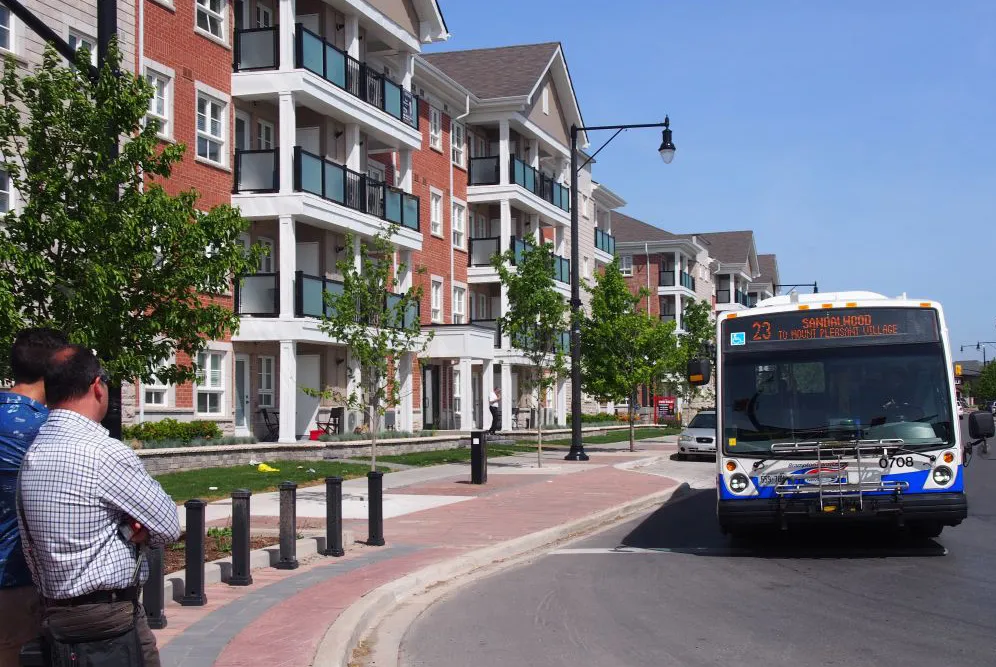We’ve known for a long time the benefits that arise when cities direct urban development to transit corridors. Developing communities around transit (and vice versa) increases housing affordability, reduces carbon pollution, protects farmland and natural spaces, reduces municipal infrastructure spending, and the list goes on. Transit-supportive development gives residents and commuters more transportation choices so they don’t have to depend on a car.
However, knowing the how and why is just the first step in transit-supportive development. Plans and support from all levels of government and developers is needed. In the Greater Golden Horseshoe (GGH) — the wider region surrounding the City of Toronto — a provincial Growth Plan and an ambitious transportation plan are in place to spur transit-supportive development. Elsewhere, the City of Ottawa has set its own density targets and is investing heavily in light rail transit (LRT).
Knowing the how and why is just the first step in transit-supportive development.
Growth policy is only one piece of the puzzle. Other factors — namely, market conditions, adequate infrastructure, and political vision — are equally influential in what ultimately gets built. It’s not hard to find cases where transit-supportive development has been held back because one or more of these ingredients is missing. As a case in point, several stations on the older portions of the University-Spadina corridor of the TTC subway line have densities well below accepted resident and job densities for subway station areas (200 combined residents and jobs per hectare).
Because they set land use policy and regulate development, cities are critical to achieving transit-supportive development. The good news is that many cities are stepping up and leading the way.
In our new research, supported by Evergreen and with input from the Housing Action Lab, we’ve uncovered city-led innovations aimed at creating the right conditions for transit-supportive development and maximizing public and environmental benefit. Many cities are taking charge by working closely with the development industry, demonstrating what is possible, conducting critical studies, or directly incentivizing development. Below, we highlight three examples.
Smart parking regulations
From an economic perspective, parking regulations can make or break a development. Studies have found that the demand for parking in developments around stations can be much lower than established guidelines require. Freeing up this land leaves more space for homes, shops and offices in these high-demand locations.
In the futureB-line LRT corridor in the City of Hamilton, the city introduced maximum (rather than minimum) parking regulations for residential development of 1.25 spaces per unit and reduced minimums for commercial parking. On the other side of the same coin, bicycle parking requirements were improved.
Durham Region, home to three GO rail stations, is developing a coordinated parking strategy which may include reduced parking requirements, parking maximums and permitting shared parking. Likewise, the region is looking to support a shift away from free parking by both leading by example at municipal offices and by supporting Metrolinx in implementing paid parking around GO stations.
Integrated planning
Land use, transportation, and infrastructure planning usually happen in silos, to the detriment of transit-supportive development. However, emerging examples of integrated planning show the benefits of a coordinated approach.
Dundas Connectsis a master planning process for Dundas Street in the City of Mississaugawhere the land use vision, public realm design and appropriate mode of transit are being developed in tandem. This means that the choice of transit type (BRT) was made during the land use planning process — not before. The integrated project team has staff from the planning and building, and transportation and works, including urban designers and landscape architects. Importantly, provincial funding for the master planning process was explicitly tied to the development of an integrated land use and transportation vision and Metrolinx participated in the city-led team. This approach could be reproduced in other corridors.
Flexible zoning
In most markets, it can be difficult for municipalities to gauge future real estate demand. Zoning that provides a degree of flexibility is one way to manage this uncertainty.
Ahead of the Confederation LRT opening in 2018, the City of Ottawa introduced a new flexible zoning category for station areas. While vacant land is required to meet the new regulations immediately, existing developments can choose to remain under the former zoning, even if they redevelop or renovate. This two-tiered approach allows owners to wait for the right market conditions while permitting higher and denser developments when possible. Read our transit-supportive development series for more examples.
We can still do better
Certainly, there is plenty of room to further accelerate transit-supportive development in Ontario’s cities. First, the outcomes from these local innovations need to be measured, assessed, and shared widely. More fundamental shifts are needed, too: we need to start seriously choosing transit routes that spur viable real estate markets and explore land value capture approaches. We need to integrate affordability and energy efficiency considerations. This research shows momentum is building in the right direction.







